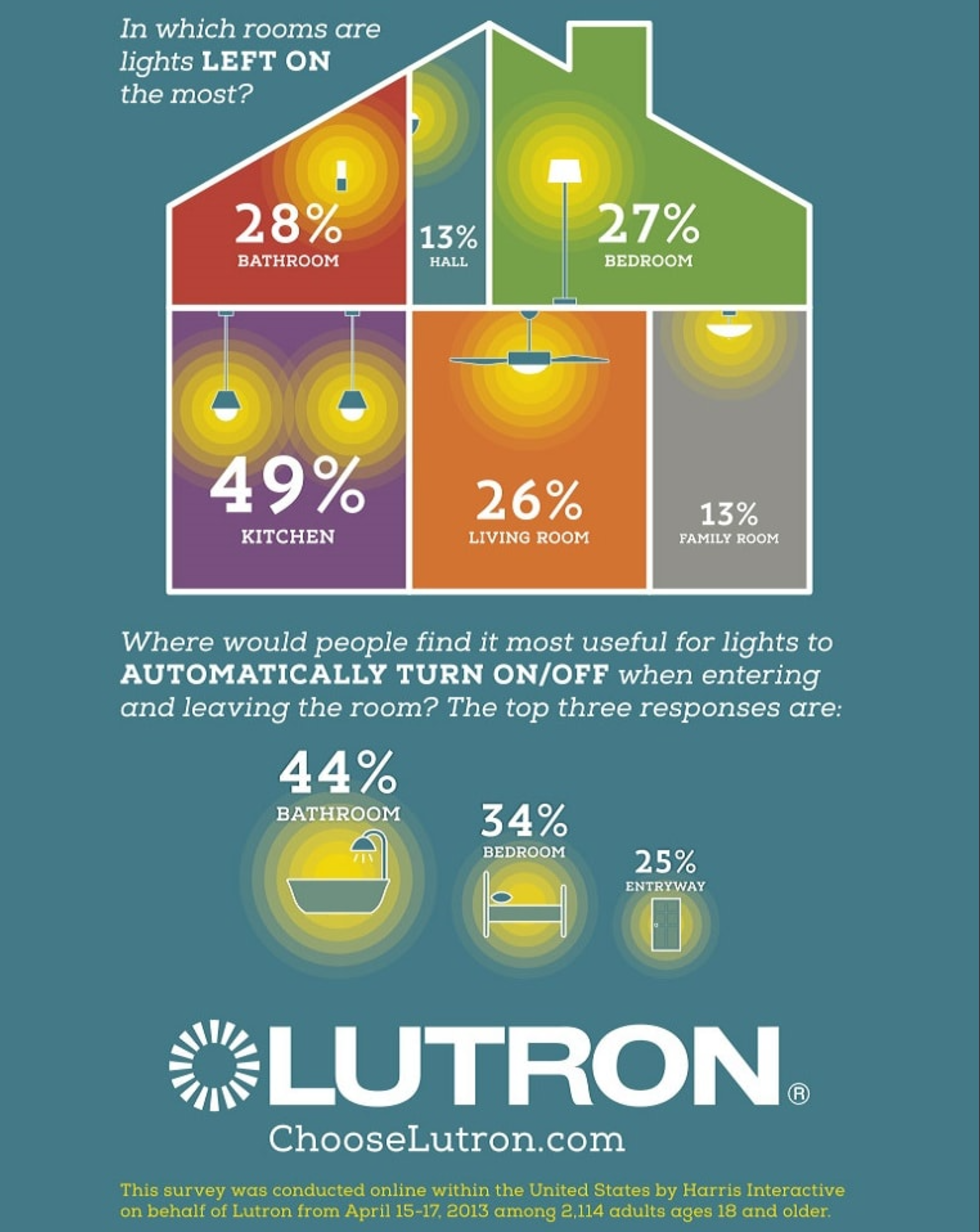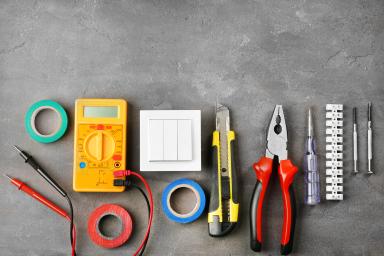Home Energy Guide: Energy Efficient Lighting

For most people, paying monthly energy bills is an afterthought. You may notice small monthly changes and grumble as the total cost increases, but you probably accept these fluctuating costs as part of life and move on without thinking twice. In reality, this negligence can be a costly habit.

Simply put, energy bills add up quickly. There are a few parts of the home that are responsible for large percentages of your monthly bill, and lighting is among the biggest energy guzzlers. According to the U.S. Energy Information Administration, about 15% of an average home’s energy is spent keeping the lights on.2
You don’t need to live in the dark to cut their energy bills, and we don’t want you to. In fact, most people can cut their spending on lighting by more than 50% with very few changes! Some changes are simple and can be done yourself, while others are more complicated and may require calling in a professional to help. In this guide, we’ll explore some of your options, and explain how these changes help you save money and energy for years to come.
Easy DIY Lighting Fixes
Replacing your light bulbs is one of the easiest ways to cut your energy bill. All you need to do is head to the store and buy the appropriate energy-efficient light bulbs. Before you but any new bulbs, watch this short video to understand the meaning of lumens, the key measure for light bulbs. This will help you buy the right bulbs for your preferences. Here's a quick rundown of your different light bulb options:
Traditional incandescent light bulbs: These are likely the bulbs you have in your home if you haven’t replaced them in a while. Incandescents have a terrible record for energy inefficiency, and a much shorter lifespan than the alternatives. The reason these bulbs are so inefficient is that 90% of their energy is given off as heat. Some of these bulbs are so inefficient they fail to meet federal standards and are no longer in production. 3
If you have any old incandescent bulbs still lighting up your rooms, it's time to replace them with one of the more efficient options on the market:
Compact Fluorescent Bulbs (CFL): CFL bulbs use 75% less energy than traditional incandescent ones and last 10 times longer, so you save big on energy bills and replacement costs. CFL bulbs contain about 4 milligrams of Mercury, which is not released unless the bulb is broken. Check out the EPA’s guide to safely dispose of CFL bulbs for more information on safe use and disposal of bulbs.
Light-emitting Diode Bulbs (LED) – LED bulbs use the latest technology and manage to use 75-85% less energy and last 25 times longer than traditional bulbs.4
https://www.youtube.com/watch?v=LYSYn-zbTrg
You’ll need to spend some money upfront to buy the new bulbs, but in most homes switching to energy efficient light bulbs will pay for itself within the first year! And because you won’t have to worry about buying replacements, you’ll continue to save for years to come.
If you’re not comfortable spending money to replace all of your bulbs right away, you can save a lot just by replacing the 4-5 that you use the most often. That alone could save up to $75 per year. 5
Bonus Tip: If you put up holiday lights each year, replace those with high-efficiency versions for huge savings. You can easily find LED holiday lights and some of the money you save can go toward extra gifts or holiday celebrations.
Intermediate DIY Lighting Fixes
Changing your light bulbs requires very little effort or upfront cost and can make a big difference, but there are a few bigger changes you can make that could have a huge payoff. These are a little more difficult than our first tip, but most people can manage on their own.
Use Motion Sensor Switches
You’re human. You probably forget to turn the lights off sometimes. 90% of people admit it happens in their home. 6 How many times have you spent money to light a room nobody was in? Motion sensor lights can tell when someone’s actually there, so the lights come on when they’re needed and turn off automatically when they’re not, helping eliminate human error.

Depending on your needs, both indoor and outdoor motion sensor lights may be a good option. Outdoor sensors are particularly convenient for getting into your home at night, and thwarting away criminals. Installing motion sensors is a bit more complicated than replacing your light bulbs, but it’s simple enough that most can handle it:
Instructions to install an outdoor motion sensor
Instructions to install an indoor motion sensor light
Use Dimmers
A dimmer switch gives you the option to change how much energy you’re using based on what you actually need. During the day when the sun’s bright, you can turn your lighting down and save on costs. Dimmers are fairly simple to install as long as you have the right tools. You do want to be careful to check that the light bulbs you have will work with a dimmer. Some CFL bulbs aren’t compatible and if you try to use them with a dimmer, and you’ll blow out the bulb.
Advanced DIY Lighting Fixes
For these changes, you’ll want to hire a professional. Energy costs are only one benefit to these projects – both of these fixes come with aesthetic benefits as well.
Redesign Your Lighting System
A lighting designer can help you make your home lighting both more beautiful and more efficient. If you hire someone with an eye for energy conservation, they can help ensure that the placement of the lights in your home and type of lighting used will satisfy your aesthetic preferences without using any unnecessary energy in the process. Unfortunately, this isn’t a realistic option for renters, unless you have permission to from your landlord to remodel your space.
Install Skylights
Want to spend less money on lighting? Take advantage of sunlight. Not only will it lower your lighting spending by 20 to 60 percent, there’s plenty of research showing daylit environments improve a room’s comfort, and helps regulate circadian rhythm.

Many homes fail to take advantage of natural light, and skylights are a stylish way to let more of this completely free resource in. Unfortunately, it’s not as simple as just calling an installer and calling it a day. You actually have a lot of options that can provide different benefits and complexities.
To start, you should consider the energy performance ratings for different skylights. Since skylights and windows have a big influence on a home’s ventilation and insulation, the Department of Energy reviews and rates the available products in order to help consumers make the most informed choice from an energy conservation perspective.
For best results, you’ll also want to consider:
Glazing: Most skylights are glazed with either glass or plastic and some use special glazing technologies to reduce the summer heat and winter cold that skylights let in.
Shape: You can find skylights in many different shapes and sizes. Tubular skylights are a good choice for minimizing the effects of hot or cold weather on your interior temperature.
Placement and Slope: Your skylight's location
will make a big difference in how useful it is for saving on lighting costs, both based on your typical use and its positioning in relation to the sun’s movements. Additionally, the slope at which it’s built will influence how much light it lets in.
Hiring a professional can help you figure out the best decision to make for all of these concerns and ensure the skylights are properly installed.
How to Hire a Lighting Professional
To find the right lighting professional to help you achieve those energy savings, here are a few things to keep in mind:
Set a goal budget: If you know what you can afford, they can help work out a project that is realistic.
Create a list of providers: It’s time to find a few professionals to compare before making a final decision. An easy way to get started is to search online, or ask friends, family members, or neighbors for suggestions.
Look at previous projects: Most lighting professionals should be able to provide pictures of work they’ve done for other clients before, so you can see if you like their style.
Check for certifications: Some good ones to look for are the
Lighting Certification (LC) and Certified Lighting Consultant (CLC). If anyone is going to work on your electrical system, it’s important to make sure they have the appropriate licensing.
Check for insurance: If something goes wrong while someone is working on your home, you don’t want to be stuck footing a much bigger bill than anticipated. Ask about their liability and workers insurance, and ask for a proof of these insurance policies to make sure they are valid. If you have any project that involves your electrical system, make sure all workers have electrical licensing. An electrical mishap can be extremely dangerous, and lead to electrocution or fire.
Compare your options: Contact a few different lighting professionals and ask for quotes. You can see how costs vary, and make a decision from there.
While all of these fixes require some upfront cost, spending a little money and effort now can save you a lot of more over time. A cheaper monthly energy bill is easy to achieve, and will leave you with the warm feeling of minimizing your environmental footprint and give you some extra savings to spend on other things you love.
Laurence KolbAuthor
Laurence has more than 30 years of experience as a licensed electrician and general contractor, focusing on building, lighting, and electrical services. He currently holds two California licenses, C10 - Electrical and B – General.
Over the course of his career, Laurence has worked on industrial, commercial, and residential projects in Los Angeles, San Francisco, and San Diego.
Sources
1. http://www.eia.gov/state/seds/data.cfm?incfile=/state/seds/sep_fuel/html/fuel_pr_es.html&sid=US
2. http://www.eia.gov/tools/faqs/faq.cfm?id=99&t=3
5. http://energy.gov/energysaver/articles/tips-lighting
6. http://www.lutron.com/en-US/general/Pages/Promos/WhoLeftTheLightsOnInfographic.aspx
7. http://www.houselogic.com/home-advice/electrical/when-time-for-electrical-wiring-upgrade/




